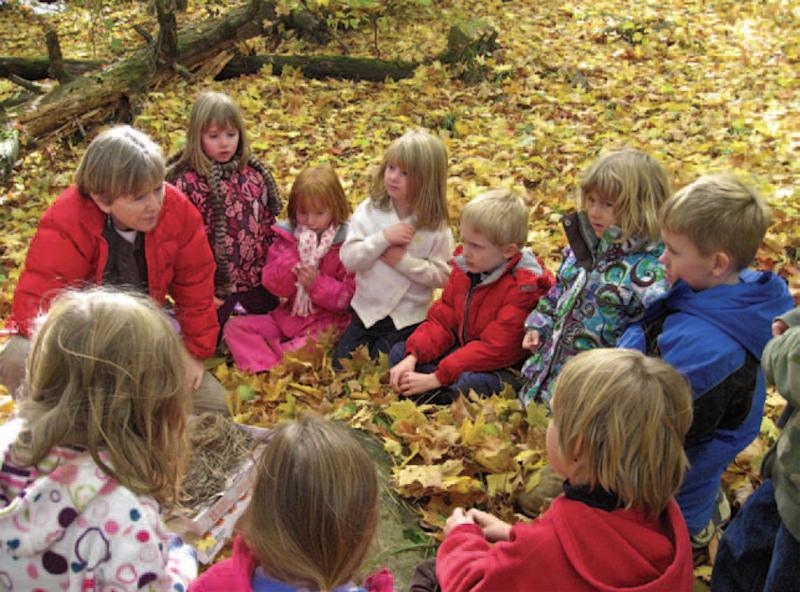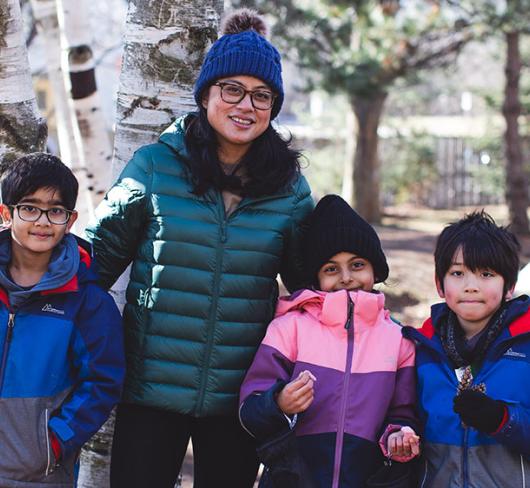
My Place Amongst Trees
Muskoka is an ideal place for an outdoor classroom. Algonquin Park lies just beyond our small town and its trees tower over the back of our schoolyard.
My commitment to taking my students outside every day is supported by Richard Louv, author of Last Child Left in The Woods; Saving Our Children From Natural Deficit Disorder, who states, “Children need nature for the healthy development of their senses, and, therefore, for learning and creativity.” Outdoor classroom experiences are not just for rural students. City children can benefit from the rich experiences offered in local parks and neighbourhoods.
To model my love of the outdoors and inspire my grade 1 class to experience nature regularly, I took them on a year-long inquiry called “My Place Amongst Trees.” Our outdoor classroom, the wooded area behind the school, became the place where they observed and sketched trees. When art was integrated into the other curricular areas (science, math, health, physical education, social studies, reading, and writing), magical things began to happen. Children with fast-paced lives outside of the classroom began to slow down and look closely and think about what they were looking at. This deepened their learning.
I began by reading Old Elm Speaks by Christine O’Connell George, an illustrated collection of prose and poetry with a strong voice and much imagery that the children responded to immediately. Reading materials were available in text sets, including both fiction and non-fiction books, poetry and magazines. I used picture books such as Leaf Man by Lois Ehlert and Sky Tree by Thomas Locker to promote different types of writing and to encourage discussion about the changes in trees throughout the year.
Following an excursion into the woods, or an experience of tree art, children’s writing became prolific. Their language and vocabulary became richer with each new experience. When children look closely at something in art, their writing is not only richer in vocabulary and better organized, but is filled with the enthusiasm of an expert. The Ontario curriculum expectations for grade 1 reading and writing were easily met.
I planned several art lessons with trees as the focus in collaboration with Andrea Bell Stuart, a teacher with a grade 1/2 multi-age classroom in Winnipeg, Manitoba. Students sketched and painted trees. They were inspired by the work of Canadian artist Tom Thomson, who painted the trees and foliage of Algonquin Park using thick paint and obvious large-brush expressionist strokes. My students sketched in hard-covered, coil-bound sketchbooks in our own little park on the schoolyard. Back in the classroom, they worked on large pieces of water colour or cartridge paper, using a variety of art techniques to express what they knew about trees.
We undertook a multi-media art project in early January. Equipped with cartridge paper on a clipboard and a sketching pencil, the children headed out to the woods to sketch, yet again. The instructions were simple: choose a tree and sketch, filling the page with the one tree. Once finished they were to look very closely at the colour and texture of the tree. Back in the classroom, they added colour and texture using oil pastels.
Using 8Vz x 11 inch Manila tag card stock for back grounds the students were asked to think about the colour and texture of winter. They created backgrounds by gluing onto the tag paper a variety of recycled materials - fabric, paper, tissue, foil, and yarn. They cut out and glued the trees they had drawn to the background. Their art beautifully represented the colour, texture, shape, and scale of trees in winter. It adorned the classroom and the school walls throughout the year.
While talking about the science of daily and seasonal cycles one day, the students wondered again about the way trees change throughout the year. This necessitated another trip to the woods to look at the trees and another look at pictures and books. It resulted in another tree sketch.
Andrea visited the classroom and conducted an art lesson. She had four old warming trays covered with foil. There were 200 crayons with the paper peeled off, sorted into seasonal colours. Students used small paintbrushes and melted wax to reproduce their sketches of trees onto a 10 by 10 inch piece of cotton fabric. (A one-inch masking tape border kept the edges the clear of wax.) Students used warm wax to paint in the colour and texture. They used the deep rich colours of pure food colour (liquid water colour could also be used) to represent the woods behind the trees. Andrea removed the masking tape borders and sewed the squares together in seasonal quadrants to make a Four Season Quilt which we hung on the classroom wall.
We took digital photographs and the students wrote a class book documenting the quilt-making process. The book was shared with one family each night.
Assessment took place throughout the inquiry. I kept anecdotal records. The students kept a portfolio with their writing, reading records, science explorations, and art projects. They helped to write rubrics for the seasonal research. Several pieces of writing were shared in class and with parents in student led conferences.
The culminating activity that tied the year-long inquiry together was a day-long trip to Algonquin Park. Students recorded their visit in sketchbooks. They visited a bog, hiked trails, observed a tree with bear claws, played nature games, and spent time in the park's visitors' museum.
When they returned, the children were inspired to write and represent what they had experienced. This included recounts, letters, and a lovely collage. They wrote another class book with photographs and sketches, which was also shared with each family.
Through numerous outdoor experiences, the children learned to use their senses to experience their surroundings and to communicate their understanding in a variety of ways. The inquiry provided opportunities for cross curricular links to different subject areas. Best of all, the children now feel more connected to the place where they live.

